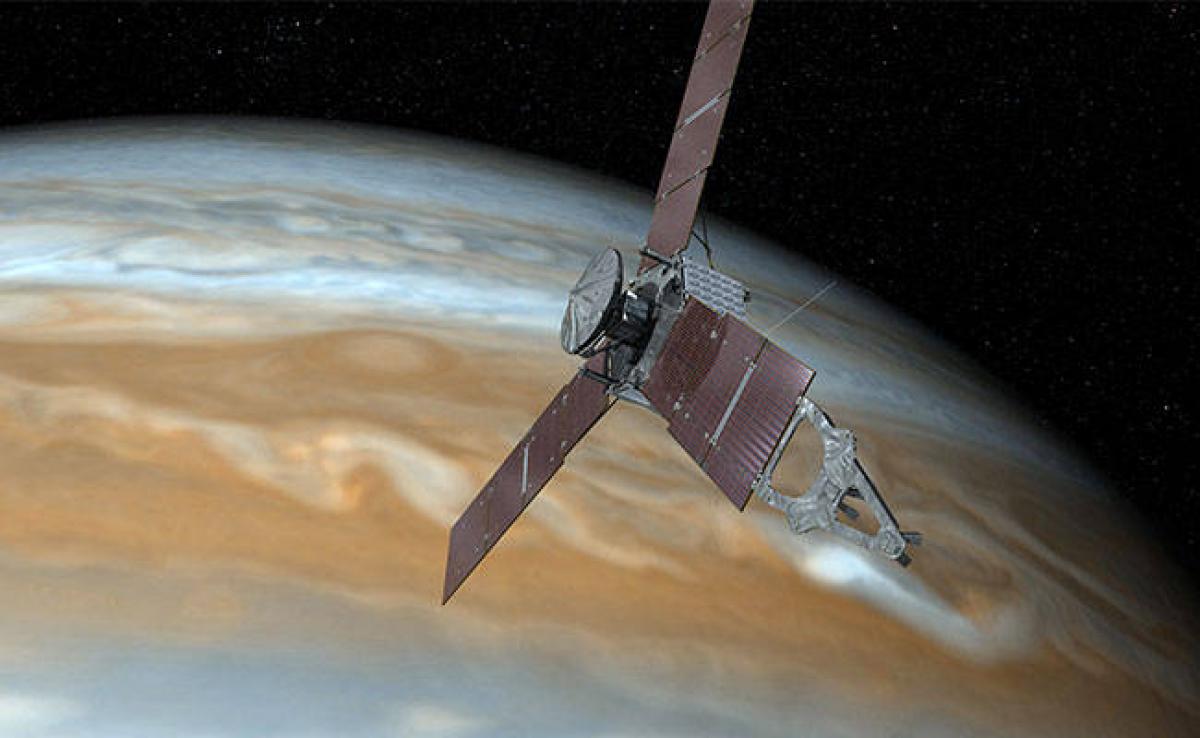Live
- Haryana CM takes dig at Punjab counterpart on setting up of new legislative Assembly
- Avvatar India and Spartan Race Kick Off India’s Ultimate Fitness Challenge in Bengaluru
- CM Revanth Reddy Pays Tribute to Guru Nanak on His Birth Anniversary
- ‘Matka’ clears censor: run-time locked
- ‘Kubera’ first glimpse looks interesting
- It took me 20 years to reach Sahnkar sir’s ears: Thaman S
- Gaurav Bhatia slams Congress for promising freebies to infiltrators in Jharkhand
- LIC’s entry into health insurance to significantly boost its market share
- Why Covid-19 Vaccine protection wanes over time?
- First Look of Kaliyugam 2064 Unveiled by Mani Ratnam Ahead of Worldwide Release
Just In

NASA\'s solar-powered Juno spacecraft, which has been probing Jupiter since July last year, will remain in its current 53-day orbit around the gas giant planet for the remainder of its mission.
NASA's solar-powered Juno spacecraft, which has been probing Jupiter since July last year, will remain in its current 53-day orbit around the gas giant planet for the remainder of its mission.
This will allow Juno to accomplish its science goals, while avoiding the risk of a previously-planned engine firing that would have reduced the spacecraft's orbital period to 14 days, NASA said.
"Juno is healthy, its science instruments are fully operational, and the data and images we have received are nothing short of amazing," said Thomas Zurbuchen, associate administrator for NASA's Science Mission Directorate.
"The decision to forego the burn is the right thing to do - preserving a valuable asset so that Juno can continue its exciting journey of discovery," said Mr Zurbuchen.
Juno has successfully orbited Jupiter four times since arriving at the giant planet, with the most recent orbit completed on February 2. Its next close flyby of Jupiter will be on March 27.
The orbital period does not affect the quality of the science collected by Juno on each flyby, since the altitude over Jupiter will be the same at the time of closest approach.
The longer orbit provides new opportunities that allow further exploration of the far reaches of space dominated by Jupiter's magnetic field, increasing the value of Juno's research, NASA said.
During each orbit, Juno soars low over Jupiter's cloud tops - as close as about 4,100 kilometres. During these flybys, Juno probes beneath the obscuring cloud cover and studies Jupiter's auroras to learn more about the planet's origins, structure, atmosphere and magnetosphere.
The original Juno flight plan envisioned the spacecraft looping around Jupiter twice in 53-day orbits, then reducing its orbital period to 14 days for the remainder of the mission.
However, two helium check valves that are part of the plumbing for the spacecraft's main engine did not operate as expected when the propulsion system was pressurised in October.
Telemetry from the spacecraft indicated that it took several minutes for the valves to open, while it took only a few seconds during past main engine firings.
"During a thorough review, we looked at multiple scenarios that would place Juno in a shorter-period orbit, but there was concern that another main engine burn could result in a less-than-desirable orbit," said Rick Nybakken, Juno project manager at NASA's Jet Propulsion Laboratory.
"The bottom line is a burn represented a risk to completion of Juno's science objectives," said Mr Nybakken.
Juno's larger 53-day orbit allows for "bonus science" that was not part of the original mission design.
Juno will further explore the far reaches of the Jovian magnetosphere - the region of space dominated by Jupiter's magnetic field - including the far magnetotail, the southern magnetosphere, and the magnetospheric boundary region called the magnetopause.

© 2024 Hyderabad Media House Limited/The Hans India. All rights reserved. Powered by hocalwire.com







